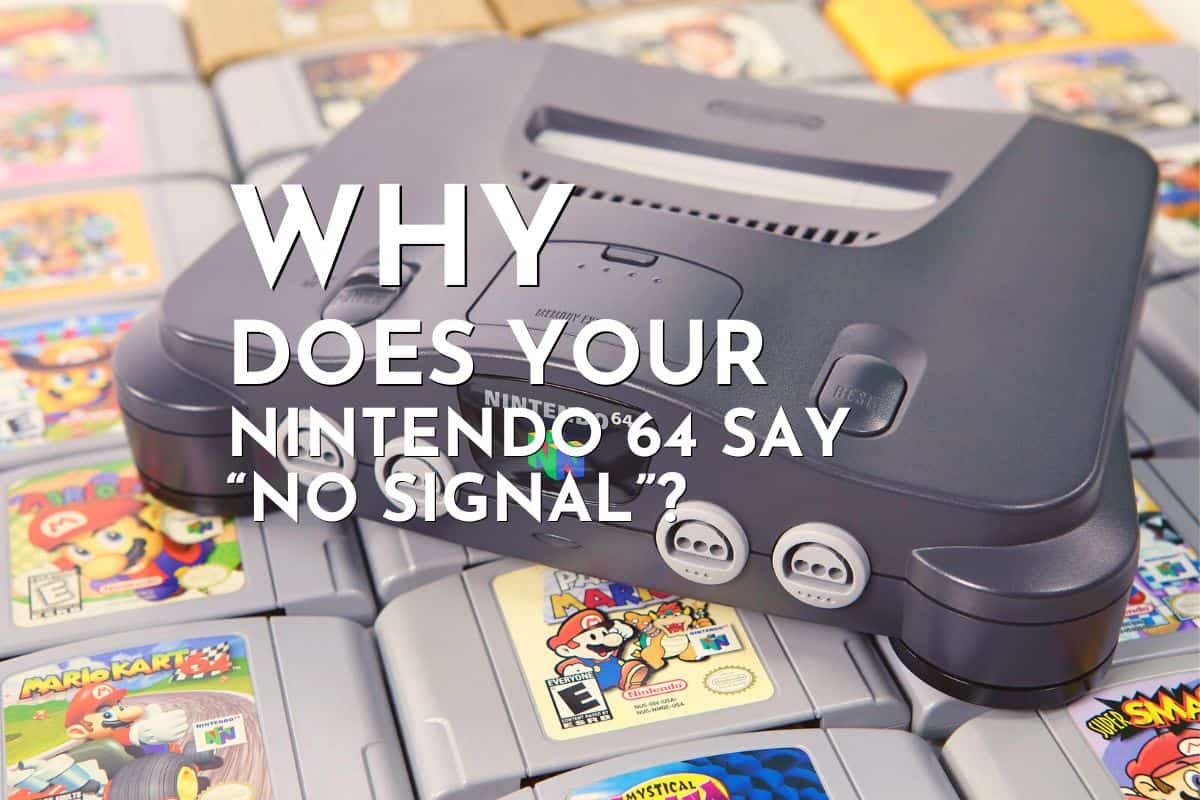Retro consoles like PS1 and N64 use analog video output, while all modern televisions operate on a digital signal (HDMI format). Many people looking to relive their childhood memories often find themselves staring at a blank screen when they plug an old console into a 4K TV. Sometimes, you might even end up with a black-and-white image on your screen.
Why is your N64 showing up as black or white? In extreme cases where the console is really old, this might be an issue with failing capacitors within the video encoding circuitry of your N64. Usually, it’s a matter of switching between composite and component inputs within your TV menu.
The Nintendo 64 shipped with composite cables in the NTSC region. And some modern TVs combine composite inputs with component inputs by using just one set of pins for both. Hence, you must tell your TV which input type you’re using (composite) otherwise you’ll end up with a black-and-white image.
Why Is Your N64 Showing Up As Black Or White?
Because of how signals are encoded in the composite format, it doesn’t translate well into a component input. Composite output has 3 pins- yellow for video, white, and red for audio. The component video standard also uses white and red for 2-channel audio but splits video into 3 separate signals (red, green, and blue).
Green transmits brightness, while blue and red contain the blue (Pb) and red (Pr) color components. Often, component video is referred to by the color space code Y/Pb/Pr. When you plug your N64 into a TV, make sure you’ve got composite video selected within the input options.
If this doesn’t fix the issue, try a different set of AV cables (replacement cables are easy to find online). If you purchased your N64 used, it might have shipped with a damaged AV cable. Remember, these consoles are over 2 decades old at this point.
The easiest fix is to purchase an HDMI adapter that lets you play your N64 on a modern TV without any hiccups. No need to switch input settings, cables, etc. Just plug in the HDMI cable, and you’re good to go (modern TVs will auto-detect HDMI input).
In some cases, the physical encoding hardware responsible for creating the analog signal within your N64 might be damaged. In that case, you have to take the console to a repair shop. Or you can just buy a used N64, which is probably going to be cheaper than replacing specific parts on your existing console.
How Do I Fix My N64 Black Screen?
Barring a dead IC or fried capacitors on the motherboard, it’s probably a loose Jumper Pak. Take a look at the little hatch on top of your N64, below the cartridge slot vent. Open it, and you should be able to remove the Jumper Pak.
This is just a filler component that serves as a termination point for the Rambus data bus when you don’t have an expansion pack. The little metal contacts at the bottom can get dirty over time as the console sits in some corner of your home and collects dust. If the Jumper Pak isn’t detected, your N64 won’t boot up and you’ll just get a black screen.
So clean up those contacts with some cotton swabs and rubbing alcohol. If you’re still getting a black screen, you might want to open up your console and check the cartridge slot. Pull it out, and clean the pins.
How Do I Know If My N64 Is Original?
Counterfeit cartridges are a menace, but fake consoles are very rare. Scammers don’t go through the trouble of creating a fake N64, because the reward is often not worth the investment considering used N64 prices. Sometimes, you might end up with an empty shell because the scammer stole all the internals for spare parts.
But that’s not something you should worry about with buyer protection on sites such as eBay/ Amazon. Plus, user reviews are a great way to determine the reliability of a particular seller (avoid new sellers with no reviews).
Now, moving on to fake cartridges- there are many ways to spot them. Unfortunately, the chances of getting scammed go up if you’re purchasing online with no access to photos of every single cartridge (they are usually sold in packs). For those who are purchasing from a local seller in person, watch this video to learn how you can spot fake N64 cartridges.
Can You Connect N64 To HDMI?
Not natively, as HDMI wasn’t a thing back in 1996. However, there are several HDMI adapters available on the market from 3rd party manufacturers. These even give you the option to switch between standard aspect ratio (4:3) and widescreen (16:9), although many N64 games will look stretched in widescreen.
Cheap HDMI adapters do have issues, like sub-optimal upscaling algorithms and input lag. Input lag is especially frustrating if you’re playing a fighting game like Super Smash Bros. Dedicated upscalers like the XRGB-Mini Framemeister are very expensive but have the best video quality and the least input lag.
If you’re a retro enthusiast and have an N64 game collection that numbers in the hundreds, you might want to do an RGB mod on your N64. Be warned- basic soldering skills and a compatible N64 are compulsory if you decided to do an RGB mod.
Will N64 Turn On Without A Game?
It will power on, but you won’t see anything on the screen. Unlike 6th-generation consoles that had startup screens, N64 doesn’t have a BIOS. You won’t get a BIOS screen or any menu, so all you can do is insert a game cartridge if you want video output.
Does N64 Look Better On Old TVs?
It does, because of how CRT technology works. There is no fixed number of “pixels” as you have with a modern LCD/ OLED TV. And scaling is handled in a much more flexible manner via the hardware itself.
Modern TVs have a fixed native resolution. Anything below this resolution has to be scaled up via software algorithms, otherwise, you’d end up with ugly black bars. That’s why old games look bad on modern TVs, the upscaling algorithm is usually optimized for motion pictures and not games.
In contrast, old-school CRTs have a much easier time displaying stuff that’s below their “native” resolution. Plus, they have that classic scanline effect that you don’t get on modern TVs. No need to connect HDMI adapters either, which add input lag to each action.
Conclusion
I hope this article helped you understand why your N64 is showing up as black and white. This problem is commonly associated with a faulty AV cable or the wrong input choice within your TV’s system menu. Modern televisions won’t autodetect old analog formats, so you have to manually input which video standard you’re using.
In the case of N64, it’s composite. Some TVs combine component and composite video into the same set of pins, so you need to check which ones you’re using. To avoid all these issues, you can purchase a simple HDMI adapter for your N64.

